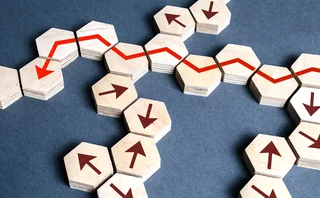
Bank monoline exposures creep up in second quarter
Second-quarter results yielded further markdowns at major dealers due to the increasing counterparty risk posed by monoline insurers.
Before the credit and liquidity crisis struck in July last year, monoline insurers underwrote billions of dollars of assets for dealers, such as super-senior tranches of collateralised debt obligations of asset-backed securities (CDOs of ABSs).
In the case of CDOs of ABSs, laying off these exposures freed up balance sheets so dealers could continue to originate new trades. But the deterioration in the credit quality of monolines has given them a lasting hangover.
From April 1 to June 30, five-year credit default swap (CDS) spreads on New York-based guarantor Ambac’s senior unsecured debt inflated from 702.47 basis points to 2,205.71bp; similarly, five-year CDSs linked to the bonds of New York-based competitor MBIA went from 736.32bp to 2,810bp, according to Citi.
Gross notional exposures – or the total amount of monoline protection held – hadn’t changed significantly for many banks in the second quarter. But a deterioration in the credit quality of monolines had caused an uptick in their net exposures, explained Tom Jenkins, senior financials analyst at Royal Bank of Scotland (RBS) in London. “Gross notional exposures haven’t changed an awful lot since the first quarter, but net exposures have increased slightly as the value of credit protection bought from monolines has dropped.”
Some banks had also been more frank about their exposures. “One of the interesting developments is there are a couple of banks that have given us a little more in the way of information,” said Jenkins.
Barclays, for instance, previously did not disclose its gross exposure – a figure now placed at £21.48 billion. The bank also reported a £3.017 billion net monoline counterparty exposure.
Similarly, HSBC unveiled a gross exposure of $14.567 billion in the second quarter and a net exposure of $2.837 billion.
Among a small number of dealers revising their gross figures upward, Citi put its total at $27.9 billion in the second quarter, from a first-quarter figure of $23.89 billion.
BNP Paribas reported gross exposures amounting to €2.7 billion in the first quarter and has now revised this upward to €16.32 billion. Its exposures were mostly to bond insurers Ambac, CIFG and MBIA, according to RBS-compiled data, and it benefited from $600 million in related hedges.
Société Générale’s gross exposure also rose in the second quarter, from €7.3 billion to €23.5 billion, although the bank claimed it held exposure mostly to higher-rated monolines, such as Ambac and MBIA.
Meanwhile, Fortis raised its gross figure from €2.8 billion in the first quarter to €3.9 billion in its second-quarter figures. This included €1.8 billion of investment-grade underlying risk and €1 billion of CDOs of ABSs, according to data collected by RBS.
At least some of the more significant gross numbers are a result of greater disclosure around negative basis trades, Jenkins and his colleagues believe. Negative basis trades usually involve buying highly rated assets and concurrently purchasing CDS protection on them. In this way, the strategy profits from the ‘negative basis’ between synthetic and cash assets.
From dealers’ second-quarter filings, discrepancies are still evident in the way banks report monoline counterparty exposures. Unlike some other banks, for example, Jenkins noted Barclays reported its exposures as banking loan risk in the second quarter. “Barclays is one of the banks that has elected to carry most of its monoline risk on the banking loan book. So it’s only going to register an impairment if there’s actually a loss recorded,” he observed.
The size of haircuts levelled for monoline counterparty risk remains varied across dealers. Adam Richmond, New York-based credit strategist at Morgan Stanley, said that, while US banks were marking gains from monolines at an average of 46 cents on the dollar, European institutions were marking them at 69 cents on the dollar. “You do see a bit of divergence between the US and Europe,” he said, adding Morgan Stanley’s “base case” was 55 cents on the dollar.
Nonetheless, differences in the marks taken against monoline-facing trades could be justified, argued Jenkins of RBS. “There are six major monolines and each one has its own credit quality or claims-paying ability. There’s more validity in having a range of marks on your monoline exposure than there would be on structured credit generally.”
See also: MBIA results mask wider malaise
Ambac clears deck of $1.4 billion CDO-squared
Further monoline downgrades likely
Doubt over opportunities for new monolines
A trick too far
Only users who have a paid subscription or are part of a corporate subscription are able to print or copy content.
To access these options, along with all other subscription benefits, please contact info@risk.net or view our subscription options here: http://subscriptions.risk.net/subscribe
You are currently unable to print this content. Please contact info@risk.net to find out more.
You are currently unable to copy this content. Please contact info@risk.net to find out more.
Copyright Infopro Digital Limited. All rights reserved.
You may share this content using our article tools. Printing this content is for the sole use of the Authorised User (named subscriber), as outlined in our terms and conditions - https://www.infopro-insight.com/terms-conditions/insight-subscriptions/
If you would like to purchase additional rights please email info@risk.net
Copyright Infopro Digital Limited. All rights reserved.
You may share this content using our article tools. Copying this content is for the sole use of the Authorised User (named subscriber), as outlined in our terms and conditions - https://www.infopro-insight.com/terms-conditions/insight-subscriptions/
If you would like to purchase additional rights please email info@risk.net
More on Credit risk
Finding the investment management ‘one analytics view’
This paper outlines the benefits accruing to buy-side practitioners on the back of generating a single analytics view of their risk and performance metrics across funds, regions and asset classes
Revolutionising liquidity management: harnessing operational intelligence for real‑time insights and risk mitigation
Pierre Gaudin, head of business development at ActiveViam, explains the importance of fast, in-memory data analysis functions in allowing firms to consistently provide senior decision-makers with actionable insights
Sec-lending haircuts and indemnification pricing
A pricing method for borrowed securities that includes haircut and indemnification is introduced
XVAs and counterparty credit risk for energy markets: addressing the challenges and unravelling complexity
In this webinar, a panel of quantitative researchers and risk practitioners from banks, energy firms and a software vendor discuss practical challenges in the modelling and risk management of XVAs and CCR in the energy markets, and how to overcome them.
Credit risk & modelling – Special report 2021
This Risk special report provides an insight on the challenges facing banks in measuring and mitigating credit risk in the current environment, and the strategies they are deploying to adapt to a more stringent regulatory approach.
The wild world of credit models
The Covid-19 pandemic has induced a kind of schizophrenia in loan-loss models. When the pandemic hit, banks overprovisioned for credit losses on the assumption that the economy would head south. But when government stimulus packages put wads of cash in…
Driving greater value in credit risk and modelling
A forum of industry leaders discusses the challenges facing banks in measuring and mitigating credit risk in the current environment, and strategies to adapt to a more stringent regulatory framework in the future
Accelerating the evolution of credit decisioning and modelling
Anthony Mancuso, director, global head of risk modelling and decisioning at SAS, explains the importance of developing a fully capable credit modelling lifecycle to empower non-specialist personnel, and offers insight into its own solutions to this end,…







